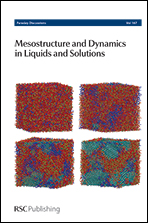Water's non-tetrahedral side
Abstract
The case for liquid water having non-tetrahedral as well as tetrahedral coordination is put forward. Given the dependence of structure on the hydrogen bond definition, a recent conceptual breakthrough has been the topological hydrogen bond definition which overcomes the shortcomings of traditional cut-off-based hydrogen bond definitions. It identifies the hydrogen bonds in water's first coordination shell using assumed transition states as boundaries instead of fixed cut-offs. Here, the topological definition is applied to liquid water to characterise the distances, angles and energies of the hydrogen bonds for the different types of coordinations found. These coordinations include bent, trigonal, tetrahedral, trigonal bipyramidal, and octahedral structures, as well as bifurcated hydrogens, bifurcated oxygens and cyclic dimers, and larger polygons. All species are shown to have properties consistent with their classification, justifying their assignments, and supporting the structure of water as a continuous, single phase mixture. However, a detailed analysis to assess the existence of the assumed transition states reveals the remarkable finding that hydrogen bond switching via a bifurcated hydrogen under certain circumstances is a barrierless process. The likelihood of a switch depends on both the acceptor numbers and on the proximity of a donor to its acceptor. Specifically, a donor in an acceptor's outermost subshell switches uphill to an acceptor of the same or higher coordination to the starting acceptor, downhill to an acceptor of lower coordination by two or more, or sits bifurcated between two acceptors if the new acceptor has a coordination lower by only one. Which it is depends intimately on the donor molecule's oscillations and on other hydrogen bond switches that control the nearby acceptors' coordinations. Finally, a search is conducted for long-range structure in water in terms of asymmetry in the distribution of the donor–acceptor bias but none is found.
- This article is part of the themed collection: Mesostructure and Dynamics in Liquids and Solutions

 Please wait while we load your content...
Please wait while we load your content...